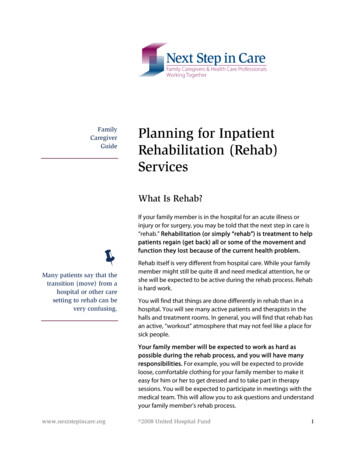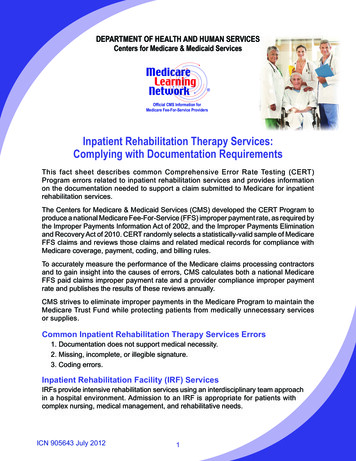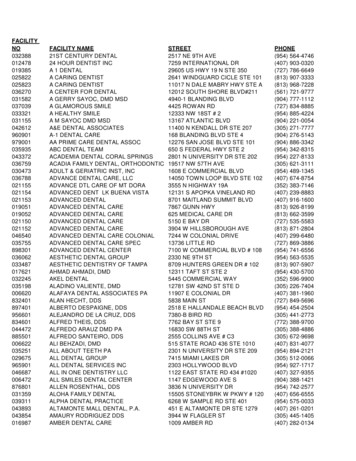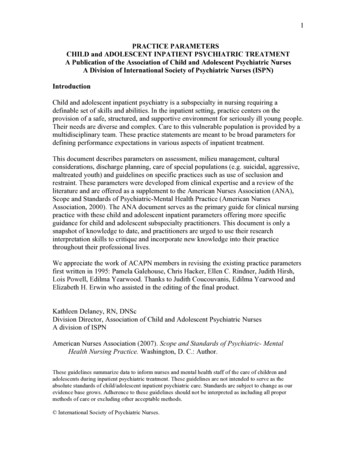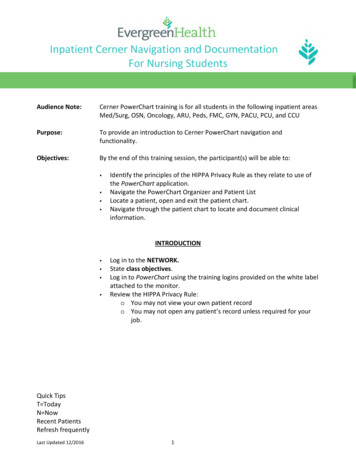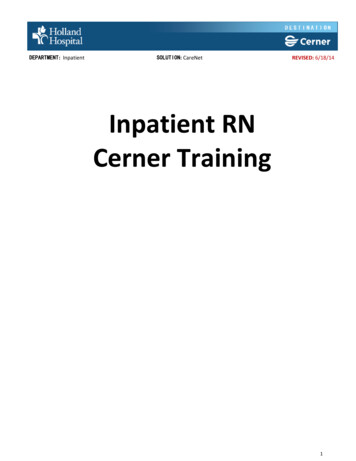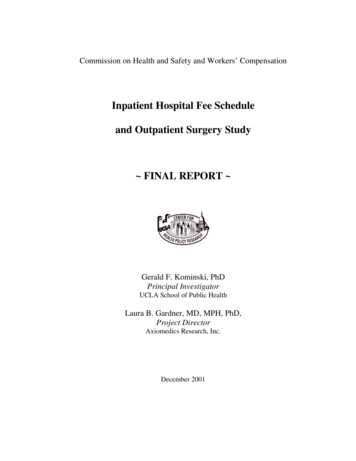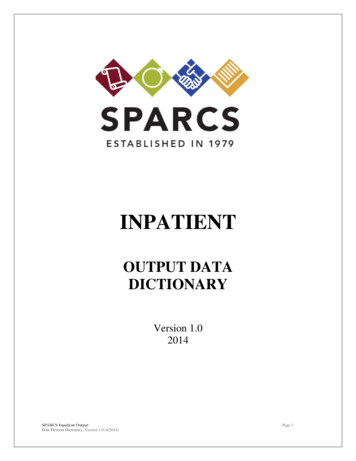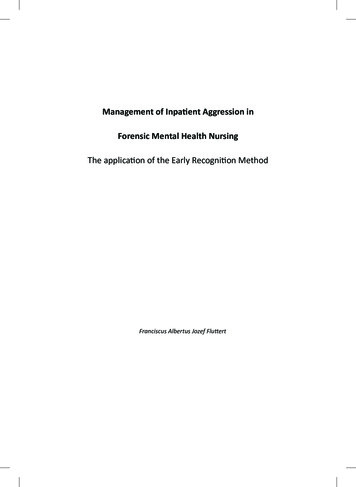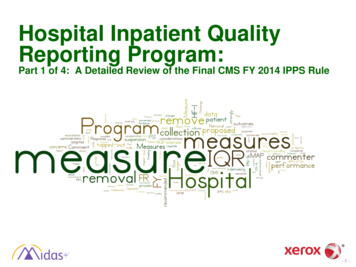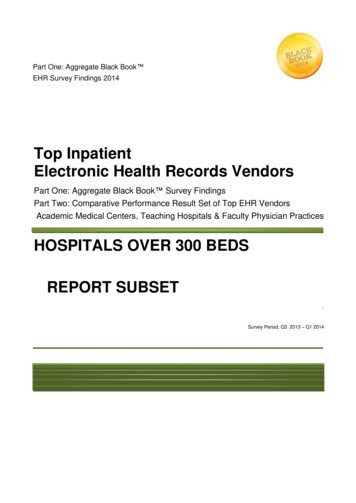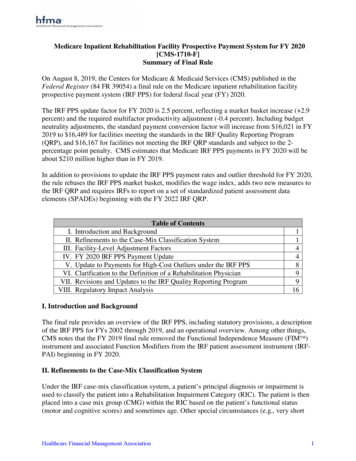
Transcription
Medicare Inpatient Rehabilitation Facility Prospective Payment System for FY 2020[CMS-1710-F]Summary of Final RuleOn August 8, 2019, the Centers for Medicare & Medicaid Services (CMS) published in theFederal Register (84 FR 39054) a final rule on the Medicare inpatient rehabilitation facilityprospective payment system (IRF PPS) for federal fiscal year (FY) 2020.The IRF PPS update factor for FY 2020 is 2.5 percent, reflecting a market basket increase ( 2.9percent) and the required multifactor productivity adjustment (-0.4 percent). Including budgetneutrality adjustments, the standard payment conversion factor will increase from 16,021 in FY2019 to 16,489 for facilities meeting the standards in the IRF Quality Reporting Program(QRP), and 16,167 for facilities not meeting the IRF QRP standards and subject to the 2percentage point penalty. CMS estimates that Medicare IRF PPS payments in FY 2020 will beabout 210 million higher than in FY 2019.In addition to provisions to update the IRF PPS payment rates and outlier threshold for FY 2020,the rule rebases the IRF PPS market basket, modifies the wage index, adds two new measures tothe IRF QRP and requires IRFs to report on a set of standardized patient assessment dataelements (SPADEs) beginning with the FY 2022 IRF QRP.I.II.III.IV.V.VI.VII.VIII.Table of ContentsIntroduction and BackgroundRefinements to the Case-Mix Classification SystemFacility-Level Adjustment FactorsFY 2020 IRF PPS Payment UpdateUpdate to Payments for High-Cost Outliers under the IRF PPSClarification to the Definition of a Rehabilitation PhysicianRevisions and Updates to the IRF Quality Reporting ProgramRegulatory Impact Analysis114489916I. Introduction and BackgroundThe final rule provides an overview of the IRF PPS, including statutory provisions, a descriptionof the IRF PPS for FYs 2002 through 2019, and an operational overview. Among other things,CMS notes that the FY 2019 final rule removed the Functional Independence Measure (FIMTM)instrument and associated Function Modifiers from the IRF patient assessment instrument (IRFPAI) beginning in FY 2020.II. Refinements to the Case-Mix Classification SystemUnder the IRF case-mix classification system, a patient’s principal diagnosis or impairment isused to classify the patient into a Rehabilitation Impairment Category (RIC). The patient is thenplaced into a case mix group (CMG) within the RIC based on the patient’s functional status(motor and cognitive scores) and sometimes age. Other special circumstances (e.g., very shortHealthcare Financial Management Association1
stay or patient death) are also considered in determining the appropriate CMG. CMGs are furtherdivided into tiers based on the presence of certain comorbidities; the tiers reflect the differentialcost of care compared with the average beneficiary in the CMG.As previously finalized, beginning with FY 2020, CMS will incorporate the data items collectedon admission and located in the Quality Indicator section of the IRF-PAI into the CMGclassification system. This was necessitated by finalizing the removal of the FIMTM instrumentfrom the IRF-PAI beginning with FY 2020.In this rule, CMS does not finalize its proposal to vary weights in calculating the motor scoreused to assign patients to a CMG. However, does revise the CMGs and update the relativeweights and average length of stay values for FY 2020 as proposed.A. Use of a Weighted Motor Score Beginning with FY 2020In the 2019 IRF PPS final rule, CMS adopted (for FY 2020 and later years) an unweightedadditive motor score for use in assigning patients to CMGs. The score is derived from 19 dataitems located in the Quality Indicator section of the IRF-PAI: eating, oral hygiene, toiletinghygiene, shower/bathe self, upper body dressing, lower body dressing, putting on/taking offfootwear, bladder continence, bowel continence, roll left and right, sit to lying, lying to sitting onside of bed, sit to stand, chair/bed-to-chair transfer, toilet transfer, walk 10 feet, walk 50 feet withtwo turns, walk 150 feet, and 1 step (curb). In finalizing this policy, CMS stated that thisunweighted score was preferable to a weighted score because it is less complex and more easilyunderstood. Beginning in 2020, the unweighted additive motor score replaces the currentweighted score, which is based on FIMTM instrument data elements.CMS had proposed to instead use a weighted motor score to assign patients to CMGs beginningwith FY 2020, but this policy is not finalized. Removal of the data item “roll left to right,” isfinalized, however. The final motor score index for 2020 is shown in Table 2, reproduced below.As previously finalized, the motor score will be the sum of the scores for these items, eacheffectively given a weight of 1.0.The decision not to move forward with the proposed weighted motor score is made in responseto the overwhelming number of commenters opposing or requesting delay in this change.Reviewing the comments, CMS concluded that the weighted score is only slightly more accuratewhile the unweighted score is less complex. It believes that use of the unweighted score willease providers’ transition to the use of the Quality Indicators section of the IRF-PAI.TABLE 2: Final Motor Score Weight Index for FY 2020ItemWeightGG0130A1 - Eating1GG0130B1 - Oral hygiene1GG0130C1 - Toileting hygiene1GG0130E1 - Shower bathe self1GG0130F1 - Upper-body dressing1GG0130G1 - Lower-body dressing1Healthcare Financial Management Association2
ItemGG0130H1 - Putting on/taking off footwearGG0170B1 - Sit to lyingGG0170C1 - Lying to sitting on side of bedGG0170D1 - Sit to standGG0170E1 - Chair/bed-to-chair transferGG0170F1 - Toilet transferGG0170I1 - Walk 10 feetGG0170J1 - Walk 50 feet with two turnsGG0170K1 - Walk 150 feetGG0170M1 - One-step curbH0350 - Bladder ContinenceH0400 - Bowel ContinenceWeight111111111111B. Revisions to CMGs and Updates to CMS Relative Weights and Average Length of StayValuesUpdates to the CMG relative weights and average length of stay values are made for FY 2020,using the same methodologies that have been used in past years, now applied to FYs 2017 and2018 IRF claims and FY 2017 IRF cost report data. The methodology is described in a March2019 technical report available at alysis2019RTI032219.pdf. The finalbudget neutrality factor is 1.0010.Table 3 in the final rule displays the final relative weights and length of stay values by CMG andcomorbidity tier. Table 20 in the impact section of the final rule (section VIII below) shows thedistributional effects of the changes in the CMGs by type of facility. For provider-specificimpact analysis of the CMG changes, CMS refers readers to the FY 2020 final rule data filesavailable ral-Regulations-Items/CMS-1710F.html?DLPage 1&DLEntries 10&DLSort 2&DLSortDir descendingCMS responds to a number of comments it received on the revisions to the CMGs. It disagreeswith commenters that the revisions will result in payment rate compression or could compromiseaccess to care for particular patients, and refers readers to the technical report cited above. CMSacknowledges that payments to providers may be redistributed as a result of revised CMGs, andwill consider monitoring the impact of the use of the Quality Indicators “section GG” items onthe distribution of patients among the CMGs for future updates. It will continue to provideeducational opportunities for the IRF community regarding training and guidance on propercoding of the Quality Indicator data items.Healthcare Financial Management Association3
III. Facility-Level Adjustment FactorsFor FY 2020, the facility-level adjustment factors (that is, the rural, low income percentage (LIP)and teaching status adjustment factors) will continue to be held at the FY 2014 levels. CMScontinues monitor the most current IRF claims data available and evaluate the effects of thechanges that were adopted in the FY 2014 final rule.IV. FY 2020 IRF PPS Payment UpdateFor FY 2020 payment, CMS rebases the IRF PPS market basket; applies the annual marketbasket update and productivity adjustment; updates the labor-related share of payment; andaligns the market basket used for the IRF PPS with that used in other PAC payment systems.A. Rebasing and Revising of the IRF PPS Market BasketThe IRF PPS market basket is rebased from a 2012-based index to a 2016-based index beginningwith the FY 2020 payment update. CMS believes that 2016 represents the most recent andcomplete set of Medicare cost report data available. The cost reports included are those forproviders with cost reporting periods beginning on or after October 1, 2015 and prior toSeptember 30, 2016.The final rule details the methodology used to rebase the market basket, which is generally thesame methodology CMS used in creating the current 2012-based IRF market basket. Thatinvolves using Medicare cost report data to calculate weights for seven cost categories: Wagesand Salaries; Employee Benefits; Contract Labor; Pharmaceuticals; Professional LiabilityInsurance; Home Office Contract Labor; and Capital. A residual category captures all remainingcosts, and detailed weights are calculated for 17 categories within this residual by using 2012Benchmark Input-Output data for hospitals as published by the Bureau of Economic Analysis(BEA). data. 1The major difference from the 2012-based market basket is that CMS derives the Home OfficeContract Labor cost weight from Medicare cost report data instead of including it among theresidual categories. The price proxies are the same as used for the 2012-based market basketalthough in some cases where blended proxies are used (e.g., chemicals; fuel, oil, and gasoline;medical instruments) the weights given to the proxies are different to reflect the updated BEAdata. Similarly, the vintage weights developed for capital-related price proxies for the 2016based market basket use the same methodology as was used for the 2012-based market basket,but the values are different to reflect updated information.CMS received a number of comments opposing the change in the method for calculating theHome Office Contract Labor cost weight. It is finalizing the proposed methods, but invitescommenters to submit additional data regarding treatment of home office expenses for IRF unitsfor future rulemaking.1Specifically, CMS applies data from the “Use Tables/Before Redefinitions/Purchaser Value” for NAICS 622000,Hospitals.Healthcare Financial Management Association4
Final rule Table 7, reproduced below, compares the final 2016-based market basket cost weightswith those from the 2012-based market basket. (Table 10, not included in this summary, showsthe 2016-based market basket weights and price proxies.)TABLE 7: Final 2016-based IRF Market Basket Cost Weights Compared to 2012based IRF Market Basket Cost WeightsCost CategoryTotalCompensationWages and SalariesEmployee BenefitsUtilitiesElectricityFuel, Oil, and GasolineWater & SewerageProfessional Liability InsuranceAll Other Products and ServicesAll Other ProductsPharmaceuticalsFood: Direct PurchasesFood: Contract ServicesChemicalsMedical InstrumentsRubber & PlasticsPaper and Printing ProductsMiscellaneous ProductsAll Other ServicesLabor-Related ServicesProfessional Fees: Labor-relatedAdministrative and Facilities Support ServicesInstallation, Maintenance, and RepairAll Other: Labor-related ServicesNonlabor-Related ServicesProfessional Fees: Nonlabor-relatedFinancial ServicesTelephone ServicesAll Other: Nonlabor-related ServicesCapital-Related CostsDepreciationFixed AssetsMovable EquipmentInterest CostsGovernment/NonprofitFor ProfitOther Capital-Related Costs2016- based IRFMarket BasketCost 31.39.06.54.12.51.50.90.61.02012-based IRFMarket BasketCost 71.38.66.44.12.31.40.90.50.8Note: Detail may not add to total due to rounding.Healthcare Financial Management Association5
Finally, Table 11 from the final rule, reproduced below, compares the percent change in the2012-based and 2016-based IRF market baskets for FYs 2015 through FY 2022 (forecasts). It isupdated from the proposed rule to reflect more recent forecasts. There are small differences in afew years and a 0.1 percentage point difference on average between the two IRF PPS marketbaskets over the entire period.TABLE 11: Final 2016-Based IRF Market Basket and 2012-Based IRF Market BasketPercent Changes, FY 2015 through FY 2022HistoricaldataForecastFiscal Year(FY)FY 2015Final 2016-Based IRFMarket Basket Index PercentChange1.72012-Based IRF MarketBasket Index PercentChange1.6FY 20161.81.8FY 20172.42.5FY 2018Average 2015-20182.32.12.42.1FY 20192.52.6FY 20202.92.9FY 20213.13.2FY 20223.13.1Average 2019-20222.93.0Note that these market basket percent changes do not include any further adjustments as may be statutorily required.Source: IHS Global Inc. 2nd quarter 2019 forecast.Responding to commenters concerned about transparency, CMS says that detailed forecasts ofthe IRF market basket are available upon request by sending an email toCMSDNHS@cms.hhs.gov. The data provided can be used to replicate historical and forecastedIRF market basket updates.B. Market Basket Update and Productivity AdjustmentAn update factor of 2.5 percent is finalized for the IRF PPS payment rates for FY 2020,composed of the following elements.Final FY 2020 IRF PPS Update FactorMarket basket2.9%Multifactor productivity (MFP)-0.4%Total2.5%The 2.9 percent FY 2020 market basket increase factor is based on IHS Global Insight’s (IGI’s)most recent forecast, which is from the second quarter of 2019. Similarly, the statutorilyrequired MFP adjustment is based on IGI’s second quarter 2019 forecast of the 10-year movingaverage (ending in 2020) of changes in annual economy-wide private nonfarm businessmultifactor productivity. (No further statutory reduction is required for FY 2020.) The updatefactor for IRFs that fail to meet requirements for the IRF QRP is discussed in section VII.Hbelow and totals 0.5 percent.Healthcare Financial Management Association6
CMS notes that the Medicare Payment Advisory Commission (MedPAC) recommends that forFY 2020 the Congress should reduce the IRF PPS rates by 5 percent, citing margins that havebeen above 11 percent since 2012.C. Labor-Related Share for FY 2020CMS adopts a total labor-related share of 72.7 percent for FY 2020, reflecting the categoryweights associated with the use of the 2016-based market basket. (The FY 2019 labor share is70.5 percent.) The 72.7 percent comes from the IGI second quarter 2019 estimate of the sum ofthe relative importance of Wages and Salaries; Employee Benefits; Professional Fees: LaborRelated; Administrative and Facilities Support Services; Installation, Maintenance and Repair;All Other: Labor-related Services; and a portion (46 percent) of the Capital-Related cost weightfrom the IRF market basket.Table 12 of the final rule compares the components of the 2019 and 2020 labor shares. Thelargest change ( 1.6 percentage points) is for Professional Fees: Labor-Related. In the rule, CMSdetails how expenses are attributed to this category.D. Wage AdjustmentCMS adopts a change to the wage index used for the IRF PPS. Historically CMS has used themost recent final IPPS wage index available, which is the pre-reclassification, pre-floor IPPSwage index values with a one-year lag. For example, for the FY 2019 IRF PPS CMS used the FY2018 pre-reclassification, pre-floor IPPS wage index. In response to a request for information,CMS has previously received comments recommending that it modify its methodology to use thesame wage index data across post-acute care settings. For the skilled nursing facility and longterm care hospital payment systems, CMS uses the concurrent year’s IPPS wage index (i.e., theFY 2019 IPPS wage index is used for these payment systems in FY 2019). CMS has previouslyargued that the one-year lag does not hinder the ability of IRFs to demonstrate their costeffectiveness relative to other post-acute providers for purposes of participating in alternativepayment models as suggested by commenters.In this rule, CMS reverses its past position and aligns the IRF wage index methodology withother post-acute care settings. Specifically, the pre-floor, pre-reclassification IPPS wage indexfor the current fiscal year will be used. For FY 2020, therefore, CMS will use the FY 2020 prefloor, pre-reclassification IPPS wage index. (This is based on 2016 hospital cost report data.) Thechange will be made in a budget neutral manner; the final budget neutral wage adjustment factoris 1.0076. Labor market delineations are updated, including addition of a new Twin Falls, Idahourban CBSA.E. Description of the IRF Standard Payment Conversion Factor and Payment Rates for FY 2020Table 13 of the final rule (reproduced below) shows the calculations used to determine the FY2020 IRF standard payment amount. In addition, Table 14 of the rule lists the FY 2020 paymentrates for each CMG, and Table 15 provides a detailed hypothetical example of how the IRF FYHealthcare Financial Management Association7
2020 federal prospective payment would be calculated for CMG 0104 (without comorbidities)for two different IRF facilities (one urban, teaching and one rural, non-teaching), using theapplicable wage index values and facility-level adjustment factors under the final rule.Table 13: Calculations to Determine the FY 2020 Standard Payment Conversion FactorExplanation for AdjustmentCalculationsStandard Payment Conversion Factor for FY 2019 16,021Market Basket Increase Factor for FY 2020 (2.9 percent), reduced by 0.4percentage point for the statutory productivity adjustmentx1.025Budget Neutrality Factor for the Wage Index and Labor-Related Sharex1.0031Budget Neutrality Factor for the Revisions to the CMGs and CMG RelativeWeightsx1.0010FY 2020 Standard Payment Conversion Factor 16,489V. Update to Payments for High-Cost Outliers under the IRF PPSUnder the IRF PPS, if the estimated cost of a case (based on application of an IRF’s overall costto-charge ratio (CCR) to Medicare allowable covered charges) is higher than the adjusted outlierthreshold, CMS makes an outlier payment for the case equal to 80 percent of the differencebetween the estimated cost of the case and the outlier threshold. From the beginning of the IRFPPS, CMS’ intent has been to set the outlier threshold so that the estimated outlier paymentswould equal 3 percent of total estimated payments, and this policy is continued for FY 2020.CMS believes this level reduces financial risk to IRFs of caring for high-cost patients while stillproviding adequate payments for all other cases.To update the IRF outlier threshold amount for FY 2020, CMS used FY 2018 claims data and thesame methodology that has been used to set and update the outlier threshold since the FY 2002IRF PPS final rule. CMS currently estimates that IRF outlier payments as a percentage of totalestimated payments will be 3.0 percent of total IRF payments in FY 2019. To maintainestimated outlier payments at the 3 percent level, CMS updates the outlier threshold amountfrom 9,402 for FY 2019 to 9,300 for FY 2020.Updates are made to the national urban and rural CCRs for IRFs, as well as the national CCRceiling for FY 2020, based on analysis of the most recent data that are available (FY 2017).CCRs are used in converting an IRF’s Medicare allowable covered charges for a case to costs forpurposes of determining appropriate outlier payment amounts. The national urban and ruralCCRs are applied in the following situations: new IRFs that have not yet submitt
used to classify the patient into a Rehabilitation Impairment Category (RIC). The patient is then placed into a case mix group (CMG) within the RIC based on the patient’s functional status (motor and cognitive scores) and sometimes age. Other special circumstances (e.g., very short . Healthcare Financial Management Association 1
